Introduction
Hershey’s was founded in 1894 by Milton Hershey, who began producing chocolate in Pennsylvania. Today, Hershey’s is one of the largest chocolate manufacturers in the world. Hershey’s milk chocolate bar was introduced in 1900; during World War II, Hershey’s produced Ration D bars for soldiers, which were designed to withstand high temperatures and provided a taste of home (Abratt & Bendixen, 2019). Hershey’s continues to innovate, introducing new products like Hershey’s Gold and expanding its global reach.
Financial Trends
Importantly, Hershey’s earnings for 2021 were $4.049 billion, an increase of 9.38% from 2020. Meanwhile, sales of the company’s products were also up 13%, largely due to an improvement in chocolate sales; thus, in 2021, sales of chocolates almost doubled (Horváth & Wang, 2021).
Current Trends
Hershey’s has been focusing launching new flavors and packaging designs for its classic chocolate products, investing in sustainability initiatives such as responsible sourcing and reducing waste, and increasing its online presence (Abratt & Bendixen, 2019).
Segmentation and Targeting
Segmentation
The market for chocolate products, such as Hershey’s chocolate, can be segmented based on demographic, psychographic, behavioral, and geographic factors (Abratt & Bendixen, 2019). By using these segmentation bases, companies can better understand their target consumers and develop marketing strategies.
Target Market
Demographics
Hershey’s products are generally enjoyed by men and women, with no specific gender bias. Chocolate consumption spans across different age groups, with adults being the primary consumers. However, Hershey’s also offers products specifically targeted at children, such as Hershey’s Kisses and Hershey’s Milk Chocolate Bars, with special packaging designs. Meanwhile, chocolate is a popular product among consumers of all races and ethnicities, and Hershey’s caters to a diverse customer base (Abratt & Bendixen, 2019). Hershey’s offers products in different sizes and packaging options, including single-serve and multi-pack options, to cater to different family sizes. The advantage is that Hershey’s products are available at a wide range of price points, making them accessible to consumers across different income levels (Abratt & Bendixen, 2019). Also, chocolate consumption is not typically associated with a specific education level, although certain types of chocolate, such as dark chocolate, are sometimes marketed as more premium or sophisticated products.
Geographics
Chocolate consumption is common across all types of areas, but there may be slight differences in consumption patterns. For example, urban areas may have more convenience stores and specialty retailers that carry Hershey’s products, while rural areas may have more grocery stores and supermarkets (Abratt & Bendixen, 2019). In addition, Hershey’s may have different product offerings and marketing strategies in other regions based on consumer preferences and cultural traditions. A Certain flavors or types of chocolate may be more prevalent in certain regions, and Hershey’s may tailor its products and marketing to appeal to those preferences (Abratt & Bendixen, 2019). Moreover, Hershey’s has a global presence and may have different product offerings and marketing strategies in different countries based on local preferences and cultural traditions.
Psychographics
Hershey’s consumers may enjoy various activities, such as watching movies, spending time with family and friends, and indulging in sweet treats to relax and unwind. Hershey’s target market may have an interest in food, cooking, and baking, as well as in indulgent treats and sweets. They may also be interested in health and wellness, which could drive them towards Hershey’s products, which are marketed as “better for you” options, such as those made with dark chocolate or added health benefits like nuts or fruit (Abratt & Bendixen, 2019). Moreover, Hershey’s consumers may have a favorable view of the brand’s reputation for quality, tradition, and nostalgia.
Benefits Sought
Hershey’s customers may seek out the brand’s products as a way to indulge in a sweet treat and enjoy a moment of pleasure or relaxation. In addition, Hershey’s consumers may value the taste and quality of the brand’s products, which are known for their rich, creamy chocolate flavor and smooth texture (Abratt & Bendixen, 2019). They may have a sentimental attachment to the brand and its products, which are often associated with childhood memories and family traditions.
Media Usage
Hershey’s target market may use social media platforms like Facebook, Instagram, and Twitter to discover new products, engage with the brand, and share their own experiences with Hershey’s products. Moreover, potential customers can use search engines like Google or Bing to research and discover new products, read reviews, and compare prices (Abratt & Bendixen, 2019). They may read food magazines or follow food blogs to find new recipes and learn about the latest food trends and products, including those from Hershey’s.
Product
Product Description
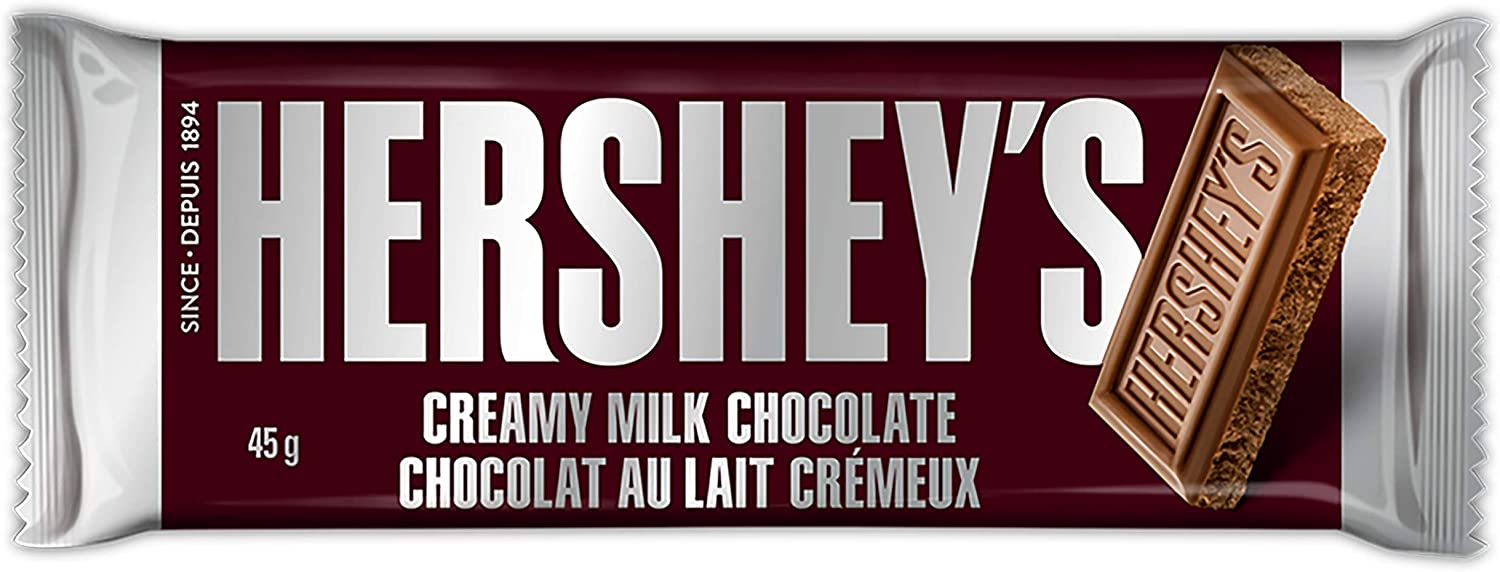
Hershey’s products are made with high-quality ingredients, including cocoa beans from West Africa, Brazil, and other regions worldwide. They come in various flavors, including milk chocolate, dark chocolate, and white chocolate (Koonar, 2018). Also, the advantage is that products can be enjoyed as a snack, dessert, or ingredient in recipes. Furthermore, Hershey’s packaging features the iconic Hershey’s logo and branding and colorful graphics and images that showcase the product inside. Hershey’s products are labeled with nutrition information, ingredients, and allergen warnings, ensuring that consumers can make informed choices about what they are consuming. The branding strategy focuses on tradition, quality, and nostalgia, leveraging its long history as a beloved American brand (Ferrell et al., 2021). Hershey’s marketing campaigns often feature fun and playful imagery, highlighting the joy and pleasure of indulging in Hershey’s products.
Hershey’s chocolate products are in the maturity stage of the product life cycle. Chocolate has been a popular treat for many years, and Hershey’s has been a leading brand in the industry for over a century (Koonar, 2018). Hershey’s has also introduced several product extensions, such as Hershey’s Kisses and Hershey’s Cookies ‘n’ Creme. These products are in the growth stage of the product life cycle, as they are relatively new and experiencing increasing demand.
Product Positioning
Hershey’s faces significant competition in the chocolate and confectionery market. Mars produces a range of chocolate and confectionery products, including Snickers, M&Ms, and Milky Way bars. It is the second-largest confectionery manufacturer in the world, after Nestle. Nestle is a Swiss multinational food and beverage company that produces a wide range of products, including chocolate and confectionery (Koonar, 2018). One of the key ways is through its focus on high-quality ingredients and traditional recipes (Ferrell et al., 2021). Hershey’s uses fresh milk from local farms and cocoa beans sourced from around the world to produce its chocolate products.
Hershey’s is positioned as a classic, nostalgic American brand that offers high-quality, delicious chocolate and confectionery products. Its major competitors are also positioned as offering high-quality, indulgent treats, with a focus on fun and enjoyment (Ferrell et al., 2021). However, each brand has its unique positioning and strengths. Mars, for example, emphasizes its fun and playful personality, while Nestle positions itself as a global brand with a wide range of products.
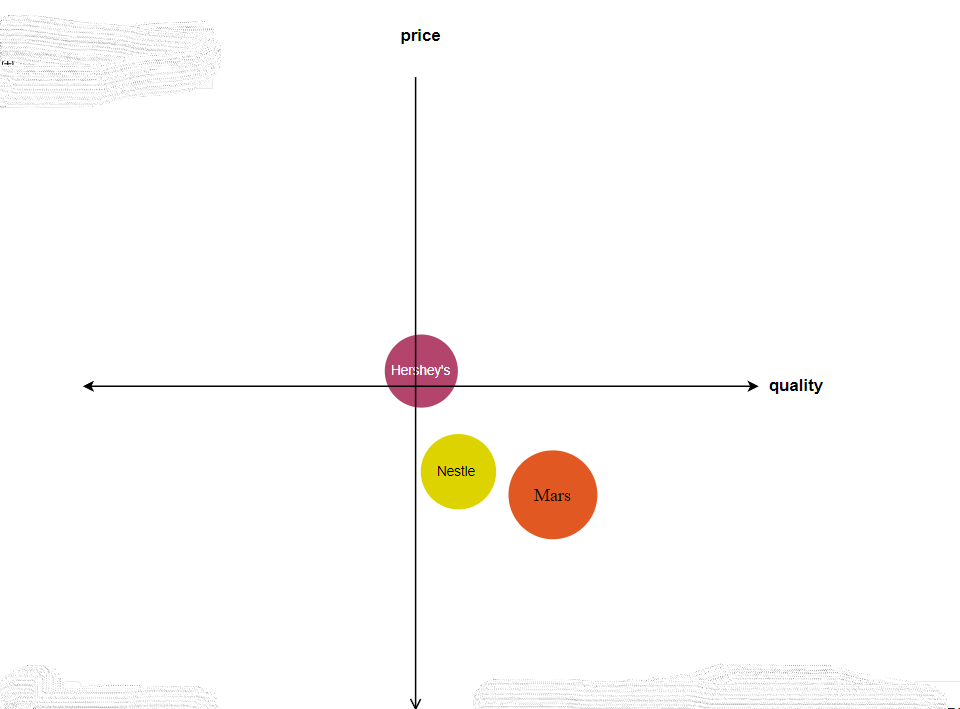
Market Share
According to the market research firm Euromonitor International, Hershey’s is one of the leading companies in the global chocolate confectionery market, with a 6.3% market share in 2020 (Horváth & Wang, 2021, p. 3). Its primary competitors include Mars, Mondelēz International, Nestle, Ferrero, Lindt & Sprüngli, and Godiva. Mars is the market leader, with a 14.9% share, followed by Mondelēz at 10.3%, Nestle at 7.9%, Lindt & Sprüngli at 5.2%, and Godiva at 0.6% (Horváth & Wang, 2021, p. 4).
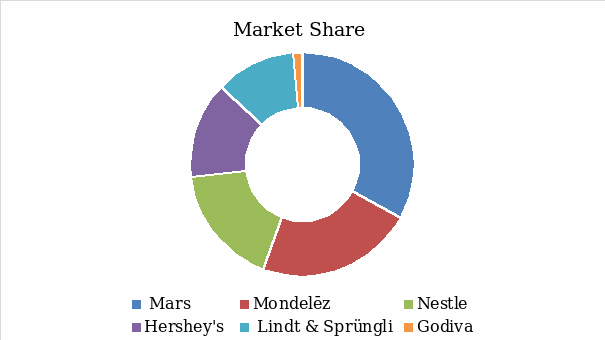
Pricing
Pricing Strategy
Hershey’s employs a penetration pricing strategy, where it sets a low price to gain market share and attract customers from competitors. This strategy helps Hershey’s to compete with other major chocolate brands in the market and capture a larger market share (Fuller, 2020).
Price Elasticity
The demand for Hershey’s products is typically inelastic; this is because Hershey’s is a well-established brand with a loyal customer base that is willing to pay a premium for its products (Fuller, 2020). Additionally, Hershey’s has successfully differentiated itself from its competitors through its branding and marketing efforts, which help to create a perception of higher quality and value. Although figure 3 shows demand-dependent goods, therefore, their prices are elastic.

Price Promotions
Hershey’s uses various promotional pricing tactics to encourage sales and promote its products. One common promotional pricing strategy is offering discounts, such as buy-one-get-one-free deals or percentage discounts, to incentivize customers to purchase more Hershey’s products (Fuller, 2020).
Price Comparisons
Name of Discount Store: Walmart
Price per unit (e.g., oz. lb.)
Hershey’s $5.90
Mars $4.47
Nestle $4.30
Name of Supermarket: Kroger
Price per unit (e.g., oz. lb.)
Hershey’s $4.00
Mars $3.60
Nestle $3.99
Name of Drug or Specialty Store: Alma Chocolate
Price per unit (e.g., oz. lb.)
Hershey’s $6.00
Mars $4.60
Nestle $ 4.30
Based on the comparative chart, it can be concluded that Hershey’s chocolate prices in all three store types are competitive compared to its main competitors Mars and Nestle. Factors that can affect shelf space allocation include sales volume, brand awareness, and advertising support (Fuller, 2020). Thus, Hershey’s chocolate occupies more shelf space than Mars and Nestle
Distribution
Distribution Intensity
Hershey’s chocolate uses an intensive distribution strategy, which means that its products are widely available in as many retail outlets as possible. This allows the brand to maximize its market coverage and reach a large number of consumers (Bateh & Sofianopoulou, 2019). Hershey’s chocolate products can be found in grocery stores, convenience stores, drug stores, vending machines, and many other locations.
Channel Diagram
The channels of distribution for Hershey’s products include various retail stores such as supermarkets, convenience stores, drug stores, and online retailers. The market, product, and producer factors that impact channel choice for Hershey’s include consumer demand and preferences, the size and weight of the product, the need for temperature-controlled shipping (Bateh & Sofianopoulou, 2019).

Warehousing and Transportation
The company also has distribution centers and warehouses in different regions to store and manage inventory before shipping to the retailers. Hershey’s transports its products through various means, including trucks, trains, and cargo ships, depending on the location and distance of the next link in the distribution chain (Bateh & Sofianopoulou, 2019).
Promotion
Advertising
Hershey’s uses a mix of advertising media, including television, print, outdoor, digital, and social media. One example of a Hershey’s print advertising is the “Pure Hershey’s” advertising that ran in magazines, featuring a large photo of a Hershey’s chocolate bar and the tagline “Pure Hershey’s – No Compromises” (The Hershey Company, n.d). Hershey’s has also used outdoor advertising, such as billboards and transit advertising, to promote its products. For example, a billboard ad for Reese’s Peanut Butter Cups featured a large image of the product with the tagline “Perfect Together,” emphasizing the combination of peanut butter and chocolate (The Hershey Company, n.d). Compared to competitors, Hershey’s advertising often emphasizes the iconic nature of its products and the emotional connections that consumers have with them.
Social Media
Hershey’s website provides information about their products, recipes, promotions, and company history. Their website also includes a section for customer service and contact information. Hershey’s social media pages include Facebook, Twitter, and Instagram (The Hershey Company, n.d). The Facebook page features photos and videos of Hershey’s products, promotions, and events. They also share user-generated content and respond to customer inquiries. The Twitter page shares similar content as the Facebook page but in a shorter format (HERSHEY’S, 2022). They also interact with customers and respond to inquiries. On Instagram, Hershey’s shares high-quality photos of their products, promotions, and user-generated content. Their content includes photos of products in creative settings and mouth-watering recipes (Hersheys, n.d.). They also use Instagram Stories to engage with their followers and share behind-the-scenes content.

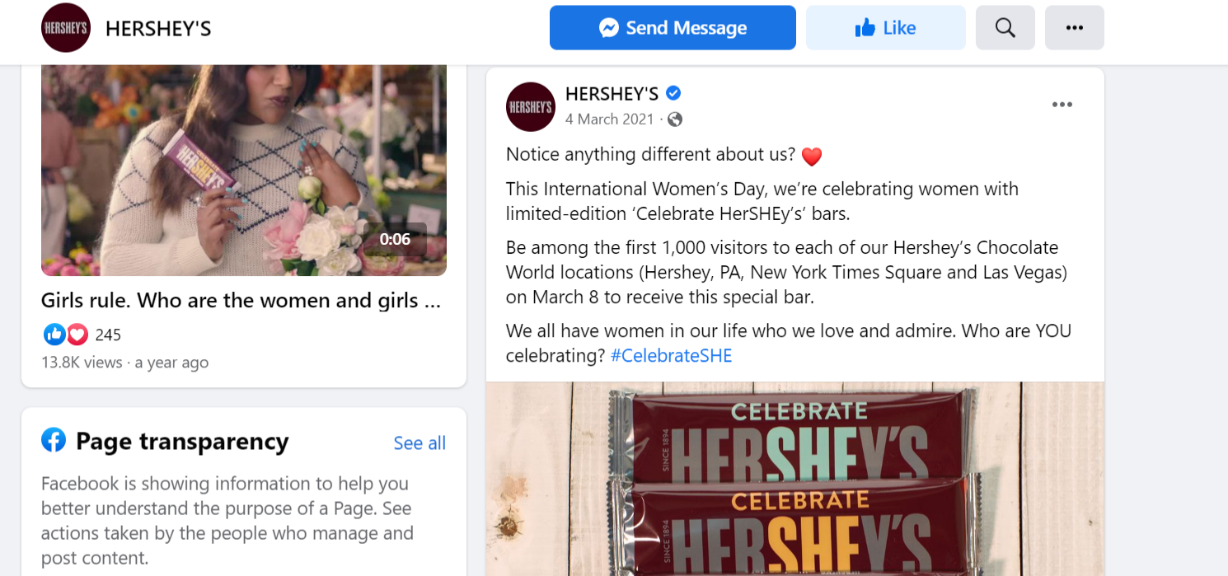


Sales Promotion
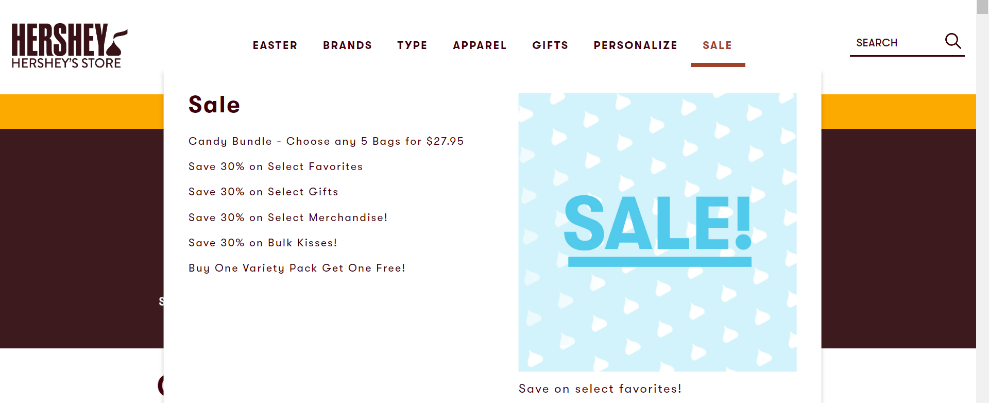
Currently, the websites offer coupons with a 30% discount on certain products. There is also a one-plus-one promotion on branded packages. Discounts presented on the site are constantly integrated into all media, including social networks. This allows the company to report profitable purchases to customers.
Publicity
It is possible to highlight publicity’s positive and negative impact on the company. Hershey’s World of Chocolate Museum and Attraction interactive attraction in Hershey, Pennsylvania, offers visitors an immersive experience to learn about the history of chocolate and Hershey’s chocolate-making process (Horváth & Wang, 2021).
References
Abratt, R., & Bendixen, M. (2019). Strategic marketing: Concepts and cases. Routledge.
Bateh, J., & Sofianopoulou, S. (2019). Organizational growth through operational change. International Journal of Business Performance Management, 20(3), 278–296. Web.
Ferrell, O. C., Hartline, M., & Hochstein, B. W. (2021). Marketing strategy (5th ed.). Cengage Learning.
Fuller, L. K. (2020). Chocolate fads, folklore, & fantasies: 1,000+ Chunks of chocolate information. Routledge.
HERSHEY’S. [@Hersheys]. (2022). Halloween party [Tweet]. Twitter. Web.
Hersheys. (n.d.). HERSHEY’S Chocolate [Photograph]. Instagram. Web.
Horváth, D., & Wang, Y. L. (2021). The examination of Fama-French model during the COVID-19. Finance Research Letters, 41, 1-10. Web.
Koonar, C. (2018). Making chocolate American: Labor, tourism, and American empire in the Hershey Company, 1903–85. The Pennsylvania Magazine of History and Biography, 142(3), 339-364. 10.1353. Web.
Scanlon, K. (2020). Chocolate, at any cost: The price elasticity of the candy industry. Web.
The Hershey Company. (n.d). Announcing fourth-quarter results. Web.
